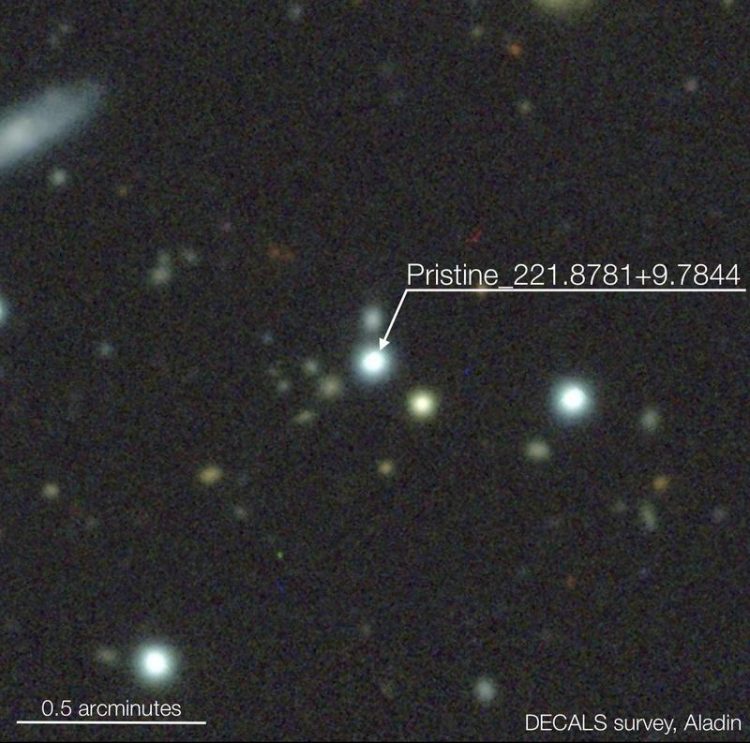Journey to the Beginning of Time

Pristine_221.8781+9.7844 and its surroundings. (Credits: N. Martin, DECALS survey, and Aladin)
In order to study the early Universe astronomers, have different methods at their disposal: One is to look to very large distances and therefore back in time, to see the first stars and galaxies as they were many billions of years ago.
Another option is to examine the oldest surviving stars from our own Galaxy, the Milky Way, and use them to get a glimpse of what the conditions were like in the early Universe. The “Pristine” survey, led by Dr Else Starkenburg from the Leibniz Institute for Astrophysics Potsdam (AIP) and Nicolas Martin from the University of Strasbourg, is looking to do just that.
The scientists employ a special colour filter on the Canada-France-Hawaii Telescope to search for stars with relatively pristine atmospheres. In their recent publication they have used this technique to discover one of the most metal-poor stars known. Detailed follow-up studies with spectrographs of the Isaac Newton Group in Spain and the European Southern Observatory in Chile have demonstrated that the star has indeed very few heavy elements in its atmosphere.
„The star contains less than one ten-thousandth of the metal content of the Sun. Additionally, its detailed pattern of different elements stands out. Whereas most heavy element depleted stars that exhibit such low levels of for instance iron and calcium do show a large enhancement in carbon, this star does not. This makes this star the second of its kind and an important messenger from the early Universe“, says Else Starkenburg.
Finding these oldest messengers is no easy task, since they are quite rare among the overwhelming population of younger stars in our Galaxy. Just after the Big Bang, the Universe was filled with hydrogen and helium and a bit of lithium.
No heavier elements were around, as these are generated in the hot interiors of stars – and those did not exist yet. Our Sun has about two percent of heavier elements in its atmosphere, as can be seen in the spectrum of its light. Because of this fact, astrophysicists can conclude that the sun has emerged as part of a later generation of stars – and is made up of “recycled” material from stars that lived long before it and have since died out.
In searching for the oldest stars, scientists look for stars with more pristine atmospheres than our Sun. The more pristine the atmosphere, the earlier the generation in which this star was born.
Studying stars of different generations allows us to understand the history of the Galaxy – an area of research that is therefore also called Galactic archaeology. The existence of a class of metal-poor stars with low carbon abundances suggests that there must have been several formation channels in the early Universe through which long-lived, low-mass stars were formed.
Dr Else Starkenburg, 0331-7499 213, estarkeburg@aip.de
Monthly Notices of the Royal Astronomical Society (Oxford University Press)
https://doi.org/10.1093/mnras/sty2276
Media Contact
All latest news from the category: Physics and Astronomy
This area deals with the fundamental laws and building blocks of nature and how they interact, the properties and the behavior of matter, and research into space and time and their structures.
innovations-report provides in-depth reports and articles on subjects such as astrophysics, laser technologies, nuclear, quantum, particle and solid-state physics, nanotechnologies, planetary research and findings (Mars, Venus) and developments related to the Hubble Telescope.
Newest articles

First-of-its-kind study uses remote sensing to monitor plastic debris in rivers and lakes
Remote sensing creates a cost-effective solution to monitoring plastic pollution. A first-of-its-kind study from researchers at the University of Minnesota Twin Cities shows how remote sensing can help monitor and…

Laser-based artificial neuron mimics nerve cell functions at lightning speed
With a processing speed a billion times faster than nature, chip-based laser neuron could help advance AI tasks such as pattern recognition and sequence prediction. Researchers have developed a laser-based…

Optimising the processing of plastic waste
Just one look in the yellow bin reveals a colourful jumble of different types of plastic. However, the purer and more uniform plastic waste is, the easier it is to…


